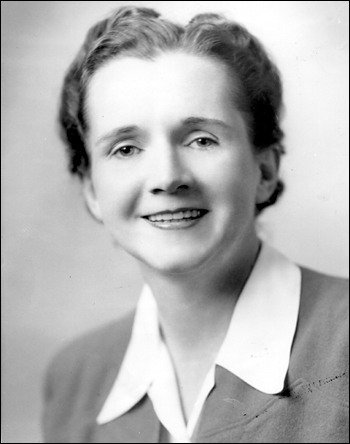On June 16, 1962, The New Yorker began publishing a serialized version of Silent Spring by Rachel Carson. Spring would eventually turn silent, Carson warned, because widespread pesticide use was killing so many birds that there might be none left to sing. The book provoked a strong reaction from the pesticide industry, but also led to tighter restrictions on pesticide use in the United States and other nations.
Born in 1907, Rachel Carson studied at The Johns Hopkins University and the Marine Biological Laboratory. She was the second woman hired by the U.S. Bureau of Fisheries for a non-secretarial position. In her spare time, she wrote newspaper and magazine articles. Between 1941 and 1955, she published three books about the ocean, leaving the fisheries bureau in 1952 to become a full-time writer. A decade later, she completed the book that made her beloved by some and despised by others.
When Carson wrote Silent Spring, dichlorodiphenyltrichloroethane (better known as DDT) was frequently used as an insecticide in domestic and agricultural applications. At the same time, multiple bird species were showing signs of decline. Carson connected the dots between pesticide use, wildlife decline, and human health.
One common misconception about Rachel Carson’s work is that she opposed all use of DDT, even when it could prevent the spread of malaria. Although she described dire scenarios of how pesticides might affect nature and people, she didn’t argue for an end to all DDT use. Instead, she argued for more cautious, targeted uses. A Nature article commemorating the anniversary of her book reported that the pesticide restrictions eventually implemented probably left DDT more effective in fighting malaria because pests had fewer opportunities to adapt and evolve.
Carson faced a firestorm of criticism for her book, but helped spur environmentalism in the United States and abroad. She did not live to see many of the consequences of her work as she had breast cancer when Silent Spring was published and died from it in 1964. As she wrote her book, iconic birds such as the American bald eagle were in decline; but by 2007, the bald eagle was removed from the U.S. Endangered Species list.
To learn more about Rachel Carson, please see the Earth Observatory feature article by guest author Brian Payton.
Reference: Dunn, R. (2012) In retrospect: Silent Spring. Nature, 485, 578–579





When I was a much younger teacher and depressed about middle school science, I would read Carson’s book, THE SENSE OF WONDER. Originally, it was a magazine article. Read it and discover your own sense of wonder and inspire wonder in others.
Thank you Rachel Carson!
Thank goodness for Rachel Carson. Because of her insight on the dire effects of DDT, I feel Ms. Carson saved many species that would no longer be with us today. As a former elementary education teacher, I learned a great deal through lessons I taught about endangered species during the early 1970s that were saved because of her efforts. We all owe a great debt to Rachel Carson. What an amazing woman!
Many thanks to you Rachel Carson!!